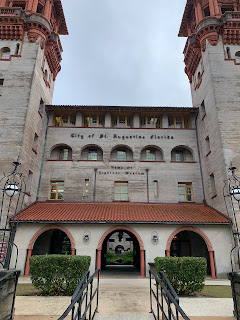March 10, 2022
St. Augustine, FL
What was known as the Alcazar Hotel built by Henry Flagler is now the Lightner Museum located in the middle of historic St. Augustine, Florida. The inside of the museum houses numerous art and history exhibits that guests can walkthrough. The art and paintings displayed in the Lightener are collections of Otto C. Lightner who bought the Alcazar Hotel in 1947. Otto Lightner turned the hotel into the museum it is today to showcase his collections that visitors come from all over the world to see.
Lightner Museum Website: https://lightnermuseum.org/
Felix F. de Crano was the artist of the painting of King Street above. De Crano was a French-American born in 1839. When Felix F. de Crano would come down to St. Augustine for the winter, he would be a part of the Flagler Colony, a group of artists here in St. Augustine. This group would stay in Henry Flagler's hotel, the Ponce de Leon, where they had access to art supplies and where they were close to the beautiful architecture of the city that they would paint. The photo above is a painting by Felix F. de Crano titled King Street Looking East done in 1906.
Artifact 2
The above display is a collection of items from the Alcazar Hotel pool. When what is now the Lightner Museum was the Alcazar Hotel, it held the largest indoor pool in the world. The Women's Swimming Championship was held here in 1925. Today it acts as an event space and holds the Alcazar Cafe.
Exterior 1
Exterior 2
In Conversation Image 1
The view of the inside of the Lightner Museum looks very similar to the inside of the Egyptian Museum in Cairo, Egypt. Both buildings have the same architectural style. The photo on the top shows the Egyptian Museum and the photo on the bottom shows the Lightner Museum. The similarities can be seen in the rounded arches and the balcony on the second floor that looks onto the lobby floor. The Lightner Museum also has many columns just like the Egyptian Museum not seen in the photo. The museum in Cairo was constructed and designed by a French architect and the museum here in St. Augustine was built and inspired by Spanish artists in the form of Mediterranean Revival style architecture. Though both museums have vast differences, the architectural styles are quite similar.
Cairo Museum Photo Link: https://lemiapp.com/michfrancesca/travel-for-history/the-museum-of-egyptian-antiquities
Lightner Museum Photo Link: https://pixels.com/featured/1-the-lightner-museum-rich-franco.html
In Conversation Image 2
The Lightner Museum held many different artifacts and one that I found interesting was the Egyptian mummy of a child from the year 500 BC. This artifact reminded me of the Royal Mummies Hall in the Egyptian Museum in Cairo, Egypt. This room displays the mummies of Egypt's past royal kings and queens. Out of the 20 mummies on display, 2 are queens and 18 are kings. The way that the Egyptians preserved bodies after death can be greatly appreciated when seeing these mummies from the 17th through 20th dynasty displayed and intact today in the Egyptian Museum.
Photo Link: https://newsus.cgtn.com/news/2021-05-19/Egypt-opens-two-new-museums-at-Cairo-International-Airport--10nB1UHrTHy/index.html
In Conversation Literature
Excerpt from Habitat Threshold
Love in a Time of Climate Change
Pablo Neruda
"I love you as one loves last seed saved within a vault"
This excerpt reminds me of the way that special artifacts are saved and taken care of in the Lightner Museum today. "The last seed saved within a vault" can refer to the paintings and collections that the museum has on display that were pieces chosen to save from history. The museum acts as a type of "vault" for these artifacts. A vault keeps something valuable and special protected and these pieces of history are worth protecting for people to come to appreciate.
Creative Component
Charcoal on paper.
Walking around the Lightner Museum I saw many sculptures of busts. The art pieces exhibited in the museum inspired me to draw my own bust out of charcoal.












No comments:
Post a Comment